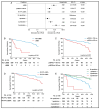Long-Term Complications Related to Cardiac Implantable Electronic Devices
- PMID: 40142866
- PMCID: PMC11942853
- DOI: 10.3390/jcm14062058
Long-Term Complications Related to Cardiac Implantable Electronic Devices
Abstract
Cardiac implantable electronic devices (CIEDs) are commonly used for a number of cardiac-related conditions, and it is estimated that over 300,000 CIEDs are placed annually in the US. With advances in technology surrounding these devices and expanding indications, CIEDs can remain implanted in patients for long periods of time. Although the safety profile of these devices has improved over time, both the incidence and prevalence of long-term complications are expected to increase. This review highlights pertinent long-term complications of CIEDs, including lead-related issues, device-related arrhythmias, inappropriate device therapies, and device-related infections. We also explore key clinical aspects of each complication, including common presentations, patient-specific and non-modifiable risk factors, diagnostic evaluation, and recommended management strategies. Our goal is to help spread awareness of CIED-related complications and to empower physicians to manage them effectively.
Keywords: CIED; CIED infection; CIED-related arrhythmias; cardiac implantable electronic devices; lead-related complications; long-term complications.
Conflict of interest statement
The authors declare no conflicts of interest.
Figures







References
-
- Haghjoo M. Practical Cardiology: Principles and Approaches. Elsevier; St. Louis, MO, USA: 2018. Cardiac Implantable Electronic Devices; pp. 251–260.
-
- Greenspon A.J., Patel J.D., Lau E., Ochoa J.A., Frisch D.R., Ho R.T., Pavri B.B., Kurtz S.M. Trends in Permanent Pacemaker Implantation in the United States from 1993 to 2009: Increasing Complexity of Patients and Procedures. J. Am. Coll. Cardiol. 2012;60:1540–1545. doi: 10.1016/j.jacc.2012.07.017. - DOI - PubMed
-
- Kusumoto F.M., Schoenfeld M.H., Barrett C., Edgerton J.R., Ellenbogen K.A., Gold M.R., Goldschlager N.F., Hamilton R.M., Joglar J.A., Kim R.J., et al. 2018 ACC/AHA/HRS Guideline on the Evaluation and Management of Patients with Bradycardia and Cardiac Conduction Delay: A Report of the American College of Cardiology/American Heart Association Task Force on Clinical Practice Guidelines and the Heart Rhythm Society. J. Am. Coll. Cardiol. 2019;140:e382–e482. doi: 10.1161/CIR.0000000000000628. - DOI - PubMed
-
- European Society of Cardiology (ESC) European Heart Rhythm Association (EHRA) Brignole M., Auricchio A., Baron-Esquivias G., Bordachar P., Boriani G., Breithardt O.-A., Cleland J., Deharo J.-C., et al. 2013 ESC Guidelines on Cardiac Pacing and Cardiac Resynchronization Therapy: The Task Force on Cardiac Pacing and Resynchronization Therapy of the European Society of Cardiology (ESC). Developed in Collaboration with the European Heart Rhythm Association (EHRA) Europace. 2013;15:1070–1118. doi: 10.1093/europace/eut206. - DOI - PubMed
-
- Al-Khatib S.M., Stevenson W.G., Ackerman M.J., Bryant W.J., Callans D.J., Curtis A.B., Deal B.J., Dickfeld T., Field M.E., Fonarow G.C., et al. 2017 AHA/ACC/HRS Guideline for Management of Patients with Ventricular Arrhythmias and the Prevention of Sudden Cardiac Death: Executive Summary: A Report of the American College of Cardiology/American Heart Association Task Force on Clinical Practice Guidelines and the Heart Rhythm Society. Circulation. 2018;138:e210–e271. doi: 10.1161/CIR.0000000000000548. - DOI - PubMed
Publication types
LinkOut - more resources
Full Text Sources

